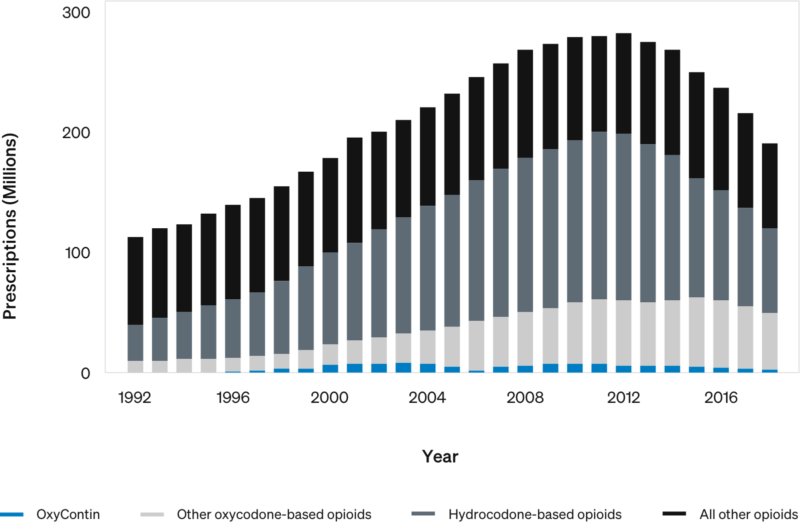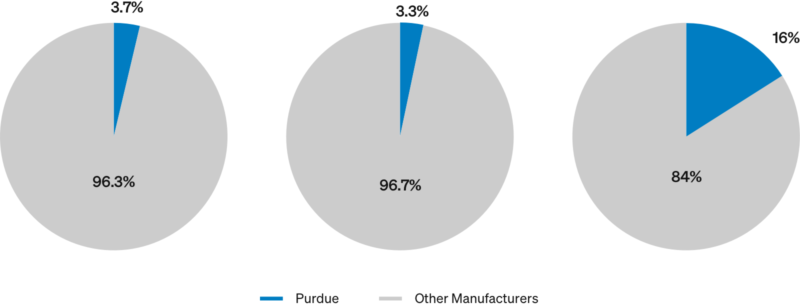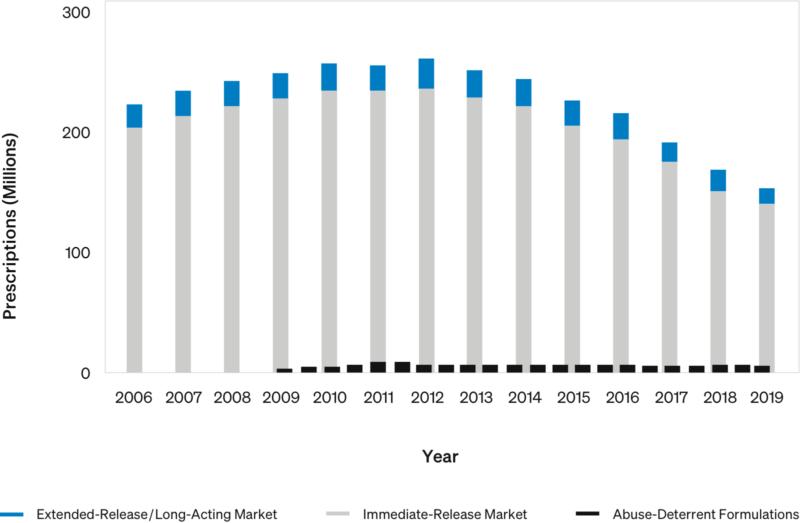OxyContin’s Market Share Has Always Been Small
Media reports often incorrectly refer to OxyContin when they should instead refer to oxycodone, the commonly prescribed generic medicine that is prescribed 7x more often than OxyContin. The reality is, prescriptions for OxyContin have never accounted for more than 4% of the prescription opioid market.
Despite this irrefutable data, and The Washington Post’s acknowledgment that Purdue Pharma was a small manufacturer of prescription opioids, the media continues to push the false narrative that OxyContin caused the opioid crisis.
The data shows[1]:
- While the rest of the prescription opioid market was growing, OxyContin’s market share was generally shrinking.
- OxyContin has never been more than 4% of opioid prescriptions (market share peaked in 2001; overall prescriptions peaked in 2003).
- OxyContin was only 1.4% of opioid prescriptions as of September 2018.
All Opioid Prescriptions: 1992–2018

Even fierce critics, including activist Ryan Hampton, cannot deny OxyContin’s market share of prescription opioids has always been small:
“Well, from OxyContin, they’re looking at numbers that are probably, you know, I mean their, their market share was small.”
Ryan Hampton, December 2021[2]
OxyContin’s Market Share Has Always Been Small, by Any Measure
3.7%
total number of prescriptions, peaked in 2001[1]
3.3%
total number of pills, averaged between 2006-2012[3]
16%
Morphine Milligram Equivalent (MME), peaked in 2001 & 2002[1]

Immediate-Release Prescription Opioids Have Always Dominated the Market
Extended-release prescription opioids, including OxyContin, have only been 9% of the total prescription opioid market, while immediate-release prescription opioids have represented 91% of the market.
Estimated number of prescriptions dispensed for all opioid analgesics from U.S. outpatient retail pharmacies: 2006-2019[4]

10 Biggest Prescription Opioid Manufacturers: 2006-2012[3]
During this time period, Purdue’s market share for OxyContin was 3.3% (measured by number of pills). At its peak, prescriptions for OxyContin never exceeded more than 4%.
| Manufacturer | Number of Pills | Market Share |
|---|---|---|
| SpecGx | 28,863,435,081 | 37.7% |
| Actavis Pharma | 26,476,395,830 | 34.6% |
| Par Pharmaceutical | 11,996,780,871 | 15.7% |
| Purdue Pharma | 2,492,496,319 | 3.3% |
| Amneal Pharmaceuticals | 2,257,973,121 | 2.9% |
| Teva Pharmaceuticals USA | 686,276,053 | 0.9% |
| KVK Tech | 580,825,207 | 0.8% |
| West-Ward Pharmaceuticals | 384,200,988 | 0.5% |
| Kaiser Foundation Hospitals | 366,492,050 | 0.5% |
| Endo Pharmaceuticals | 297,306,324 | 0.4% |
“Hydrocodone is the most frequently prescribed opioid in the United States and is associated with more drug abuse and diversion than any other licit or illicit opioid.”
dEA drug Fact Sheet[5]